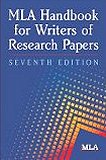

 Reference Site Map |
|
For a detailed treatment on Using Notes with Parenthetical Documentation, please see Chapter 6.5 in:

For a detailed treatment on Endnotes and Footnotes, please see Appendix B.1 in:

Information relating to MLA style as presented here has been simplified and adapted from this authoritative publication from the Modern Language Association of America.
This Chapter deals only with simple and common examples on how to write Footnote and Endnote citations. To view examples, see Chapter 8. First Footnotes and Endnotes - Examples in MLA Style as well as Footnotes - Sample Page and Endnotes - Sample Page.
Footnotes and Endnotes are used to give credit to sources of any material borrowed, summarized or paraphrased. They are intended to refer readers to the exact pages of the works listed in the Works Cited, References, or Bibliography section.
The main difference between Footnotes and Endnotes is that Footnotes are placed numerically at the foot of the very same page where direct references are made, while Endnotes are placed numerically at the end of the essay on a separate page entitled Endnotes or Notes.
In the unlikely event that you are using a typewriter, a superscript number is typed half a space above the line after the last word of the citation, e.g., "The Information Superhighway is giving way to a Commercial Superhighway."1 If you are using a word processor, you can access the superscript function. To type a Footnote citation, the same superscript number is put at the beginning of the Footnote at the bottom of the same page where the citation occurs.
When mentioning a work for the first time, a full and complete Footnote or Endnote entry must be made.
NOTE: Only one sentence is used in a Footnote or Endnote citation, i.e., only one period or full stop is used at the end of any Footnote or Endnote citation. In a Bibliography, each citation consists of a minimum of three statements or sentences, hence each entry requires a minimum of three periods, e.g., a period after the author statement, a period after the title statement, and a period after the publication statement (publication/publisher/publication date).
2 G. Wayne Miller, King of Hearts: The True Story of the Maverick Who Pioneered Open Heart Surgery (New York: Times, 2000) 245.
Miller, G. Wayne. King of Hearts: The True Story of the
Maverick Who Pioneered Open Heart Surgery. New York:
Times, 2000.
Gibaldi (313) does NOT recommend the use of these old-fashioned abbreviations: ibid. (from the Latin ibidem meaning "in the same place") and op. cit. (from the Latin opere citato meaning "in the work cited.")
For Footnote or Endnote citations, if you should see the term ibid. being used, it just means that the citation is for the second mention of the same work with no intervening entries, i.e. exactly the same work cited as the one immediately above:
Or, if the identical work is cited, but with different page numbers:
More commonly, author and page number or numbers are now used instead of ibid., e.g.:
For second or later mention of the same work with intervening entries, where previously op. cit. was used, now only the author and page number or numbers are used:
[Tab] or indent Footnote and Endnote entries 5 spaces from the left margin. Leave one space between the superscript number and the entry. Do not indent second and subsequent lines. Double-space between entries. Number Footnotes and Endnotes consecutively using a superscript, e.g., 7.
For Endnotes, you must use the same superscript number (as in your text) at the beginning of each Endnote in your Endnotes list. Start your list of Endnotes on a new page at the end of your essay. Remember to put the Endnotes page before the Bibliography, or Works Cited, or References page.
Do not confuse Footnote and Endnote citations with explanatory Notes that some authors refer to as "Endnotes." This type of "Endnotes" or "Notes" are not the same as bibliographical Footnote, Endnote or Parenthetical citations but are used to add comments, explanations, or additional information relating to specific passages in the text.